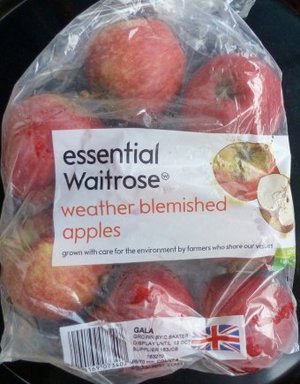It came as a real shock when my wife informed me that the local corner store was selling blemished apples. Perhaps it’s worth mentioning that our local corner store is a Waitrose supermarket and apparently they’ve done it before under the banner of fruit for jam-making.
However, selling blemished apples is neither a long way from, nor a long time since, when pre-packed fruit had to be without blemish and even in size. In 2009, an EU ban on fresh produce that didn’t match standard shapes and sizes was lifted. Up to that point as much as 20% of farm produce was thrown away or fed to livestock because it didn’t comply. Now pre-packed fruit and vegetables of mixed sizes are commonly on offer.
This year’s late frosts really hammered apple production in Northern Europe and it’s no wonder that more limited supplies mean less wastage by selling fruit that’s blemished. This is all a response to the new reality of more limited food supplies. One way to tackle a shortage of food is to reduce needless waste.
Surveys show that UK consumers are increasingly aware that there is a concern over future food supplies. This is a real turn-around. It wasn’t that long ago that Defra appeared to hold the view that UK food production was not that important. At the time I attended a meeting of researchers on the subject of sustainable land management. There was a significant number in the audience who thought that the last thing that our land should be used for was the production of food because it was far too environmentally damaging. They seemed to have no consideration that food has to be produced somewhere and that it would also inevitably be more damaging to the natural environment of the producing country than letting nature take its course.
There are other issues regarding the threat of food shortages. I’ve just read an article on the pros and cons of trying to bolster EU protein crop production. Much of the enthusiasm for this is based on the fact that non-GM supplies of soya are very limited. There are also strategic and food security reasons for the EU being less reliant on imported soya. The article’s author had calculated that 1.4 hectares of peas would have to be grown in Northern Europe to replace each hectare of soya beans grown in Brazil. In fact wheat produces more crude protein per hectare than peas in much of Northern Europe but of course the concentration of the protein in the harvested product is around half that of peas.
When you consider that land is one of the most limiting resources for food production this fact is of enormous significance. It supports the concept of free world trade in agricultural production where individual farmers only grow what they produce the most efficiently. In the UK we ‘do’ wheat and oilseed rape and in terms of land-use it is best to leave it to others to ‘do’ protein crops such as soya.
However, this bland statement hides other realities, such as the need for break crops. On the other hand, it seems that protein crops in Northern Europe have a long way to go to be competitive with soya, even when taking into account transport costs.
Let’s hope that R&D can deliver protein crops in Europe that can compete with soya or alternatively improve the prospects for home-produced soya. Until that time, financially inducing EU farmers through CAP to grow more crops than they can produce competitively in world markets or that are required to sustain a rotation doesn’t make much sense in the context of getting the best out of the current arable land in the world. It can only increase the possibility of more of the world’s remaining wild areas coming under the plough.
